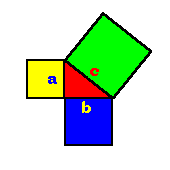Most of us ‘memorize’ (what we think is) the Pythagorean Theorem. And it seems to be one of the few things we claim to remember from math classes. My guess is, that if asked right now what the theorem is, most of us would answer (somewhat triumphantly)
a2 + b2 = c2 !!
And, we’d be partially right. To explore further, we first need some precision. This is actually more than just being picky. 🙂
Precisely, . . .
The Pythagorean Theorem is actually an IF-THEN statement/theorem, namely, IF you have a right triangle with sides a & b, and hypotenuse c, THEN the relationship a2 + b2 = c2 will always be true. If you think about it, that’s actually amazing! It always works!
Mathematically, that means that if you square (multiply by itself) one of the shorter sides of a right triangle, and add it to the square of the other shorter side, the sum will always equal the square of the hypotenuse.
The standard example is the right triangle with sides 3 & 4, and hypotenuse 5. Then (3×3) + (4×4) = (5×5), or 9 + 16 = 25. (Or try it with sides 5, 12, 13).
Amazing – even beautiful, right, but often BORING (and unappreciated) to students.
The Geometric Interpretation!
It was WELL into my career before I was shown this! (Why?!?) Look at the picture below:

Notice the RED right triangle, and the squares built on each of the 3 sides. What is the area of the yellow square, which has side a? Right – it’s a x a or ‘a squared’. Similarly, figure the areas of the blue and green squares, as ‘b squared’ and ‘c squared’, respectively.
Another way of ‘seeing’ the Theorem is that the AREAS of the yellow and blue squares together EQUAL the area of the green square!! Now, that’s beautiful, amazing, and interesting!!
The Generalized Theorem!
Once one sees the geometric interpretation above, a very fascinating fact can be appreciated (without having to ‘do the math’). The Pythagorean Theorem is not just true for squares!! Look at the figure below:

With the same orginal right triangle (labeled slightly differently here, though that is no problem), the theorem is still true for these figures (regular pentagons). The area of A, added to the area of B, is EQUAL to the area of C !! Doesn’t that send shivers of joy up and down your mathematical spine?!? 🙂
One final sidelight:
Returning to the IF-THEN statement at the top of the page . . . it turns out that the IF-THEN statement is also true the ‘other way’ (called the converse, as in “. . and conversely . . “). IF you have a triangle with sides a,b, and c, and the a2 + b2 = c2 relationship is true THEN you must have a right triangle! (It won’t work any other way.)
Comments are closed